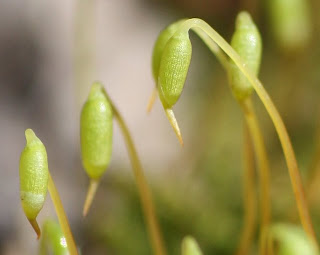 For many more pictures from this hike, see the Picasaweb album.
For many more pictures from this hike, see the Picasaweb album.
We had an hour to spare before getting Morgan and her boyfriend Ben back to Ben's house, and Morgan asked if we could take a hike to the quarry. The dilapidated structures along that section of trail fascinate her, and she enjoys photographing them. I was particularly quick to say yes because I'd just gotten a new camera: a Canon EOS Rebel XSi with a Tamron 90mm macro lens. I was eager to get the new rig onto the trail and find some small subjects.


We hiked in from Quarry Road, and almost immediately I got a pleasant surprise: a wee
bloodroot poking up through the leaf litter blanketing the south side of the trail. Apparently I haven't seen them this early in the year before, because I never knew that the leaf wrapped itself around the blossom stalk like a slender woman wrapping her cloak around herself for warmth. But what surprised me more was the fact of its location: I've never seen a bloodroot growing in such a dry and sunny spot. This was my first hike with Ben, so I took the opportunity to tell the story of how native Americans used the red sap of the roots to dye their clothes, and how it's illegal to pick the plant because it's endangered.

The patch of moss shown here is about 3" wide.

The patch of moss shown here is about 3/8" wide.
Minutes later my eyes landed on the melange of greens and browns in a small patch of moss. Then I saw the tiny stalks sprouting up through the mat, and I was hooked. I got myself into macro mode: kneeling, crouching, bracing my elbow on whatever was available, and exhaling smoothly in calculated intervals, I started snapping away.
Three days before, when I got the camera, I didn't know a thing about SLR photography. During those three days I gave myself a crash course. Between my friend Karen's uncle Joe and various internet resources, I gained a theoretical understanding of
apertures,
shutter speeds and
ISO settings. That's sort of like saying "I gained a theoretical understanding of juggling." It takes a long time and a lot of work to go from understanding it to being able to do it well. This was the first step on that path.
 The little heads on the moss sprouts are between 1/8" and 1/4" long.
The little heads on the moss sprouts are between 1/8" and 1/4" long.
The depth of field of this new macro lens is stunningly shallow, so I kept refocusing on different clusters of the little capsule heads nodding on their slender stalks. I also experimented with different F-stops*. I wanted to get a sense of my aperture limits for handheld shooting, so I didn't use the tripod yet. I didn't bother going above F8 because I figured I'd get nothing but blurs if I narrowed the aperture too much.



It wasn't long after I tore myself away from that first subject that I was captivated by a trio of them. A pair of bloodroot stood in front of one of the many remnants of the old railroad: a rusty spike jutting from a tie that was slowly being overcome by moss. This time I set up the tripod and used the two-second timer so that I wouldn't be touching the camera when the shutter went off. I wanted to see what my effective aperture limits are for tripod-mounted field shots.
I started with the two bloodroot, moving all the way up from F/2.8 to F/32 while focusing on the nearest one, then moving the focus to the farther one and going back down to F/2.8. I see that the shot I chose to show both flowers in the same frame was taken at F/16. I'll have to review my original shots to be sure, but this may confirm the claim I read that this lens starts to produce softer images once the F-number goes higher than 16.


I moved on to the railroad spike, again trying different F-stops. These two shots show the dramatic difference in mood between F/14 and F/2.8. I particularly like the F/2.8 shot because I find that having everything blurred but the spike, the tree trunk, and the narrow strip of tie, gives it a feeling that's intimate, even lonely.
I finally tore myself away from the flowers and the spike when Morgan and Ben came back, Morgan excitedly telling me to come look at what they'd found. It was the same stone structure Mary and her fellow hikers wondered at
two weeks ago. I put a mental star next to my mental note to research it. I should have taken a picture of it! Oh well... next time.

While the youngsters hung out by the quarry I went ahead to where the trail reenters the trees. This is where, during the summer, we found lots of snails and a few tiny frogs. I didn't find any frogs or occupied snail shells, but I was very pleased with the closeup shot of a shell that turned out to be empty.

Right after I left the shell I saw rabbit remains of a fresher sort than the coyote droppings Grace and I saw
a few weeks ago. It seems likely that coyotes were responsible for this too.

On the way back I got some shots of one of the
coltsfoot that are sprouting near the quarry, and some of the first bloodroot I saw. Then I snapped away at the lovebirds. There was smooching. It's good to know that a hike with dad doesn't kill the romance.
*
To see the camera settings I used, click the "more info" link to the right of any photo in the Picasaweb album.


















